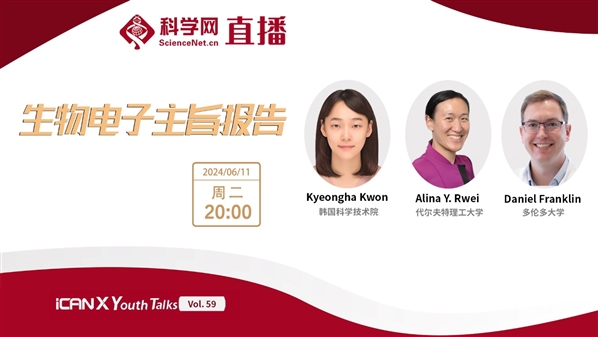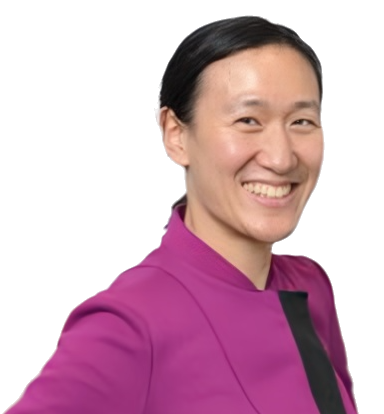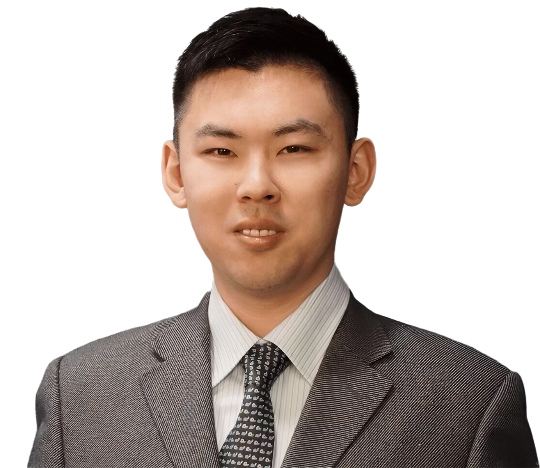
直播时间:2024年6月11日(周二)20:00-22:00
直播平台:

科学网APP
https://weibo.com/l/wblive/p/show/1022:2321325044110426767516
(科学网微博直播间链接)

科学网微博

科学网视频号
北京时间6月11日晚八点,iCANX Youth Talks第五十九期邀请到了韩国科学技术院Kyeongha Kwon,代尔夫特理工大学Alina Rwei,多伦多大学Daniel Franklin三位教授主讲,北卡罗来纳大学教堂山分校Wubin Bai教授担任研讨嘉宾,Mengdi Han担任主持人,期待你一起加入这场知识盛宴。
【嘉宾介绍】

Kyeongha Kwon
韩国科学技术院
The Role of Wireless Technologies in Shaping Digital Healthcare
【Abstract】
Viral pandemics, exemplified by COVID-19, underscore the increasing importance of non-contact, remote patient monitoring via wireless medical devices. These systems collect medical health metrics and vitals, such as blood pressure, heartbeat, respiration rate, hydration levels and various biomarkers of different diseases from the user’s devices. Typically utilizing medical wearables and mobile applications, users transform their smartphones into portable laboratories for advanced diagnostics and continuous disease tracking. In this talk, I will discuss the wireless, flexible devices such as an implantable cardiac monitor, and different non-invasive platforms to improve the digital healthcare system, overcoming spatial-temporal gaps in current healthcare provision.
病毒大流行,以COVID-19为例,突显了通过无线医疗设备进行非接触式、远程患者监测的重要性日益增加。这些系统收集医疗健康指标和生命体征,如血压、心跳、呼吸率、水分水平以及不同疾病的各种生物标志物,从用户的设备中获取。通常利用医疗可穿戴设备和移动应用程序,用户将他们的智能手机转变为便携式实验室,用于高级诊断和持续疾病跟踪。在本次演讲中,我将讨论无线、柔性设备,如植入式心脏监测器,以及不同的非侵入性平台,以改善数字医疗系统,克服当前医疗提供中的空间-时间差距。
【BIOGRAPHY】
Kyeongha Kwon (Seoul, 1988) is an Assistant Professor in the School of Electrical Engineering, as well as a joint professor in the Department of Semiconductor Engineering, and the Graduate School of AI Semiconductor at KAIST. Her research interests span a wide range of topics in wireline communication, bioelectronics, and battery management system. She is an active Technical Program Committee (TPC) Member of IEEE International Solid-State Circuits Conference (ISSCC) and IEEE Custom Integrated Circuits Conference (CICC). In 2024, she has served as the Country Representative of Korea for the ISSCC Far-East Region. Since 2023, she has held the position of Kwon Oh-Hyun Endowed Professor, funded by Oh-Hyun Kwon, the former Chairman and CEO of Samsung Electronics.
Kyeongha Kwon(首尔,1988年)是韩国高等科技学院电气工程学院的助理教授,同时也是半导体工程系和人工智能半导体研究生院的联合教授。她的研究兴趣涵盖了有线通信、生物电子学和电池管理系统等多个领域。她是IEEE国际固态电路会议(ISSCC)和IEEE定制集成电路会议(CICC)的活跃技术计划委员会(TPC)成员。2024年,她担任ISSCC远东区韩国的国家代表。自2023年以来,她一直担任由三星电子前董事长兼首席执行官权五铉资助的权五铉特聘教授职位。

Alina Y. Rwei
代尔夫特理工大学
Shedding light on precision biosensing: from wearable bioelectronics to single-particle detection
【ABSTRACT】
Optical-based biosensing platforms have the potential to enhance our insights into personalized, real-time diagnostics. Wearable bioelectronics are essential in the development towards such patient-centered technologies, yet current limitations in biosensing also emphasize the need of understanding the fundamentals of biosensing on a single molecule level. In this talk, I will discuss our efforts in the development of soft, flexible wearable optical-based bioelectronics for the monitoring of cerebral hemodynamics on one of the most fragile patient populations: neonatal and pediatric patients. The discussion will then be followed by our work on an aptamer-based biosensor for the real-time, optical detection of endotoxin, a deadly pyrogen. We demonstrate the regeneration and reusability of the sensor suitable for repeated endotoxin measurement. The single molecule detection mode is enabled by dark field microscopy. These platforms have the potential to advance biomarker detection to safeguard the whole value chain: from healthcare products to the health of our patients for real-time detection and diagnostics.
基于光学的生物传感平台有潜力增强我们对个性化、实时诊断的洞察力。可穿戴生物电子设备在发展以患者为中心的技术中至关重要,然而当前生物传感的局限性也强调了在单分子水平上理解生物传感基本原理的必要性。在本次演讲中,我将讨论我们在开发柔软、灵活的可穿戴基于光学的生物电子设备方面的努力,用于监测脑血流动力学,特别是在最脆弱的患者群体中:新生儿和儿科患者。接着,我将讨论我们基于适配体的生物传感器的工作,用于实时、光学检测内毒素,这是一种致命的热原。我们展示了传感器的再生和可重复使用性,适用于重复的内毒素测量。暗场显微镜使单分子检测模式成为可能。这些平台有潜力推进生物标志物检测,以保障整个价值链的安全:从医疗产品到我们患者的健康,实现实时检测和诊断。
【BIOGRAPHY】
Dr. Rwei is an assistant professor in TU Delft. She received her undergraduate and Ph.D. degrees at the Massachusetts Institute of Technology (MIT), with her undergraduate degree in Chemical Engineering and Ph.D. degree in Materials Science and Engineering. Her Ph.D. training was conducted under the supervision of Professor Robert Langer at MIT and Professor Daniel Kohane at Harvard Medical School. She then proceeded to a postdoctoral position in Professor John Rogers’ lab at Northwestern University. She was the recipient of the Postdoctoral Fellowship Research Training Award (TL1) from the Clinical and Translational Science Awards
Program by NIH/NCATS. Her postdoctoral work pioneered the development of flexible, wearable biosensors designed to have a miniaturized size and mechanical softness suitable for fragile populations such as neonates and children. As a principle investigator in TU Delft, she aims to work at the interdisciplinary fields of precision medicine and chemical engineering, developing biomedical technologies in sensing and therapy for next-generation medicine. Her experience has yielded publications in high-impact journals including Nature Medicine, Nature Biomedical Engineering,
Proceedings of the National Academy of Sciences (PNAS) and Science Advances.
Dr. Rwei 是代尔夫特理工大学的助理教授,她在麻省理工学院(MIT)获得了本科和博士学位,本科学位是化学工程,博士学位是材料科学与工程。她的博士训练是在麻省理工学院的Robert Langer教授和哈佛医学院的Daniel Kohane教授的指导下进行的。之后,她在西北大学的John Rogers教授的实验室担任博士后职位。她曾获得美国国立卫生研究院/临床与转化科学奖(NIH/NCATS)的博士后研究培训奖(TL1)。她的博士后工作开创了柔性、可穿戴生物传感器的开发,这些传感器设计具有微型尺寸和机械柔软性,适合新生儿和儿童等脆弱人群。作为代尔夫特理工大学的首席研究员,她致力于在精准医疗和化学工程的交叉领域工作,为下一代医学开发生物医学技术,用于传感和治疗。她的经历带来了在高影响力期刊上的发表,包括《自然医学》、《自然生物医学工程》、《美国国家科学院院刊》(PNAS)和《科学进展》。

Daniel Franklin
多伦多大学
Wearables for Continuous Hemodynamic Monitoring and Classification
【ABSTRACT】
Heart failure occurs in approximately 64 million people annually and is one of the leading causes of death globally. Characterized by periods of stability punctuated with life-threatening spells of instability, patients periodically travel to clinics for cardiac assessments. While vital, these visits incur extensive resources and only provide data during the time of evaluation. Wireless, non-invasive, monitoring devices (i.e. wearables) are gaining popularity with patients and clinicians for providing data in between hospital visits – allowing for improved insight and early, timely intervention. However, many of these devices are still limited to heart rate, pulse oximetry, and activity levels.
Here, we summarize our recent progress towards comprehensive cardiovascular monitoring and status classification by utilizing multiple, custom, time-synchronized wearables. Through wearable spectrometers and pulse arrival time models, we target independent correlates of hemodynamic function that not just estimate blood pressure, but also the regulatory mechanisms by which it is maintained or modulated. When applied to remote patient management, we posit that this will enable clinically actionable insights via the ability to classify and monitor types of heart failure and its progression in remote environments.
心力衰竭每年影响约6400万人,是全球主要的死亡原因之一。它以稳定期和生命威胁的不稳定期为特征,患者需要定期前往诊所进行心脏评估。虽然这些访问至关重要,但它们消耗了大量资源,并且仅在评估期间提供数据。无线、非侵入式监测设备(即可穿戴设备)因其能在医院访问之间提供数据而受到患者和临床医生的欢迎——这有助于提高洞察力并实现早期及时干预。然而,许多这些设备目前仍仅限于监测心率、脉搏血氧饱和度和活动水平。
在这里,我们总结了我们在利用多个定制的、时间同步的可穿戴设备进行全面心血管监测和状态分类方面的最新进展。通过可穿戴光谱仪和脉搏到达时间模型,我们针对血流动力学功能的独立相关因素,不仅估计血压,还包括维持或调节血压的调节机制。当应用于远程患者管理时,我们认为这将通过能够在远程环境中分类和监测心力衰竭的类型及其进展,从而提供临床上可行的洞察。
【BIOGRAPHY】
Daniel Franklin is an Assistant Professor in the Institute of Biomedical Engineering at the University of Toronto, and the Ted Rogers Chair in Cardiovascular Engineering at the Ted Rogers Centre for Heart Failure. He received his doctorate in Physics at the University of Central Florida studying light-matter interactions and developing experimental optoelectronic technologies. As a Post-Doctoral Fellow at Northwestern University, he worked with Professor John Rogers in the fields of bio-integrated electronics and soft-matter photonics. There, Professor Franklin developed novel bioresorbable materials, laser systems, and flexible wireless implants and wearables for hemodynamic monitoring. Throughout this work, he has won numerous awards including the Baxter Young Investigator Award and the Displaying Futures Award from Merck KGaA, Germany – the world’s largest producer of liquid crystal material. Now, in his new role at University of Toronto, Professor Franklin’s lab combines optics, engineering, and physiology to produce medical technologies for commercial translation, in partnership with industry-leading semiconductor manufacturers.
Daniel Franklin 是多伦多大学生物医学工程研究所的助理教授,同时也是 Ted Rogers 心脏衰竭中心的 Ted Rogers 心血管工程主席。他在中佛罗里达大学获得了物理学博士学位,研究光与物质的相互作用,并开发实验性的光电子技术。作为西北大学的博士后研究员,他与 John Rogers 教授一起在生物集成电子学和软物质光学领域工作。在那里,Franklin 教授开发了新型生物可吸收材料、激光系统以及用于血流动力学监测的柔性无线植入物和可穿戴设备。在这项工作中,他获得了众多奖项,包括巴克斯特青年研究者奖和德国默克公司(全球最大的液晶材料生产商)的 Displaying Futures 奖。
在多伦多大学的新角色中,Franklin 教授的实验室结合光学、工程学和生理学,与行业领先的半导体制造商合作,生产医疗技术以供商业转化。
【主持人】

Mengdi Han
北京大学
【研讨嘉宾】

Wubin Bai
北卡罗莱纳大学教堂山分校
特别声明:本文转载仅仅是出于传播信息的需要,并不意味着代表本网站观点或证实其内容的真实性;如其他媒体、网站或个人从本网站转载使用,须保留本网站注明的“来源”,并自负版权等法律责任;作者如果不希望被转载或者联系转载稿费等事宜,请与我们接洽。